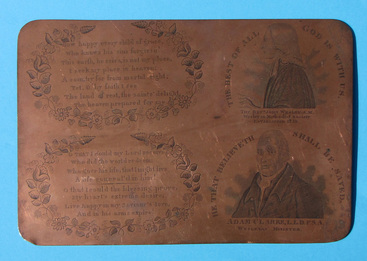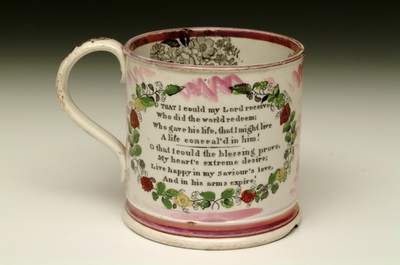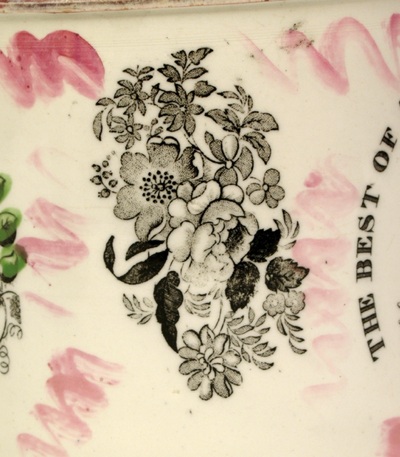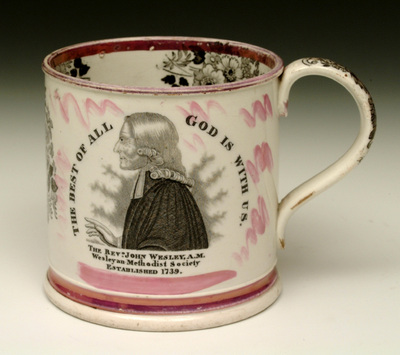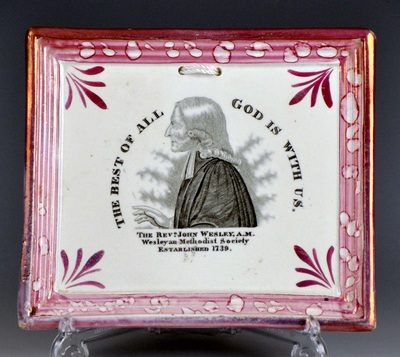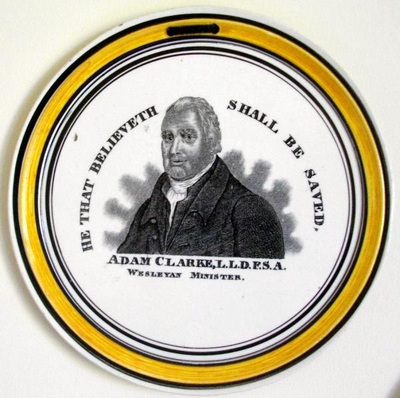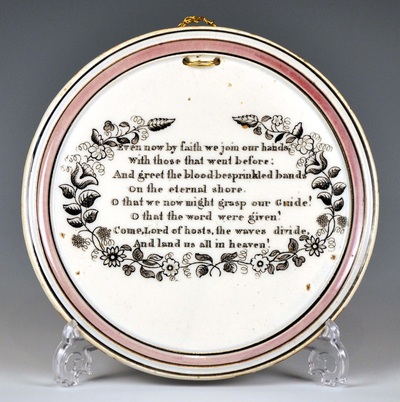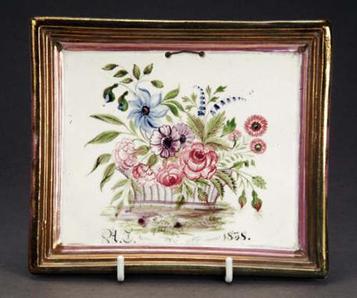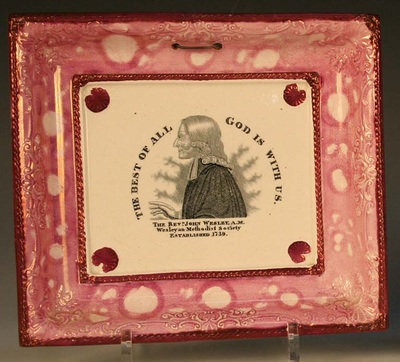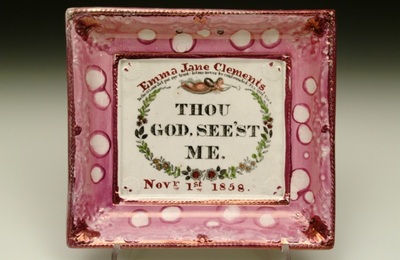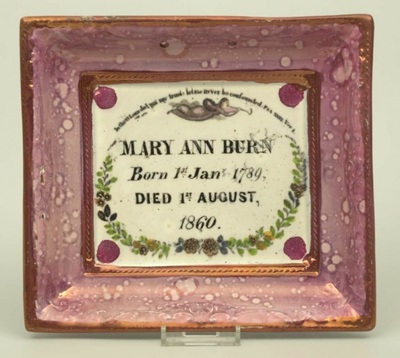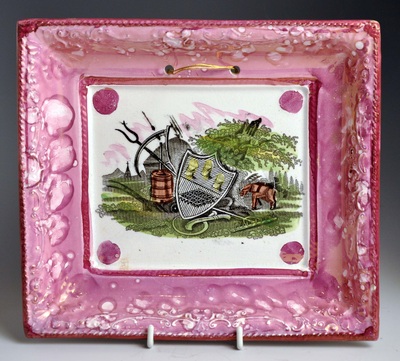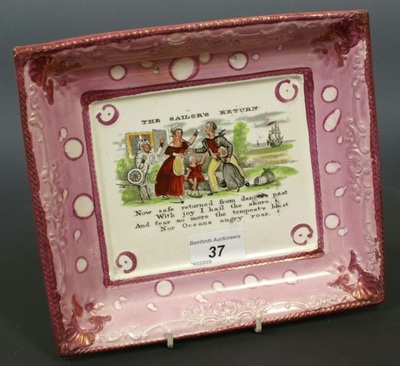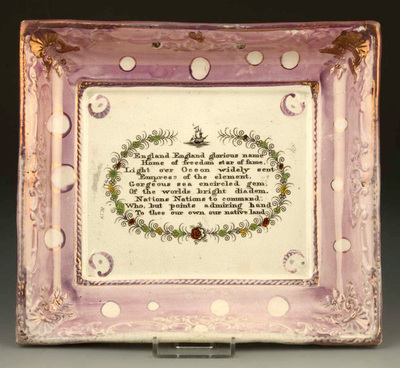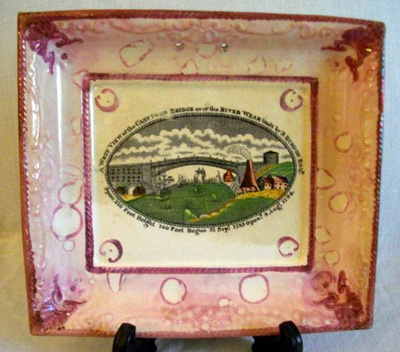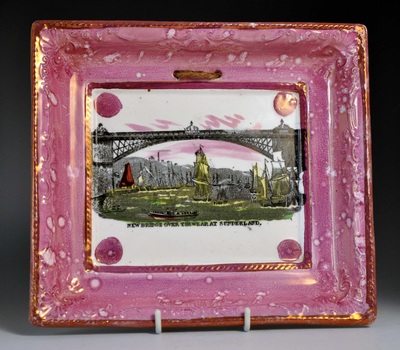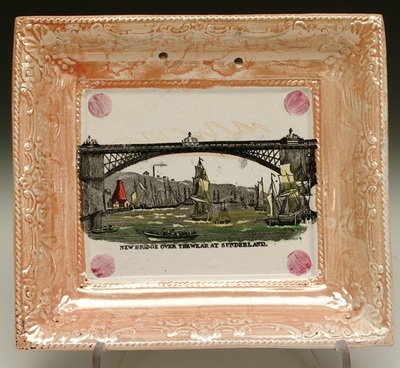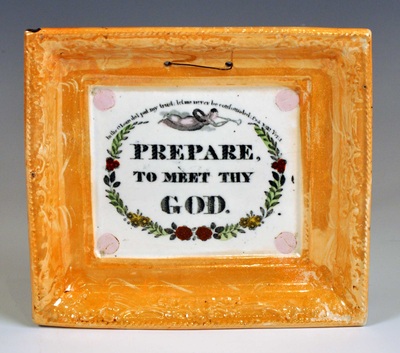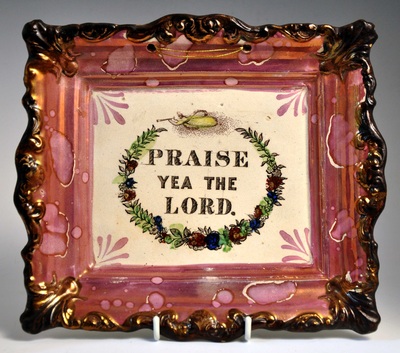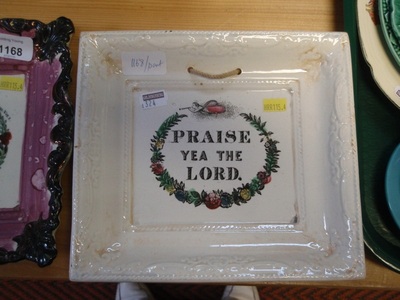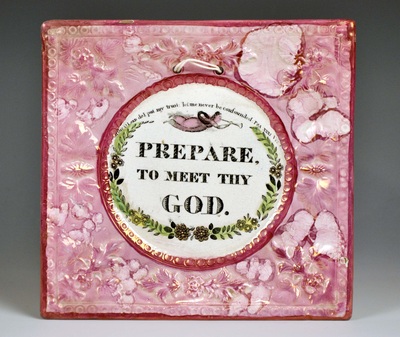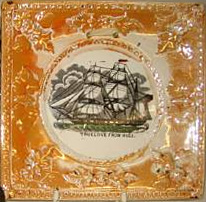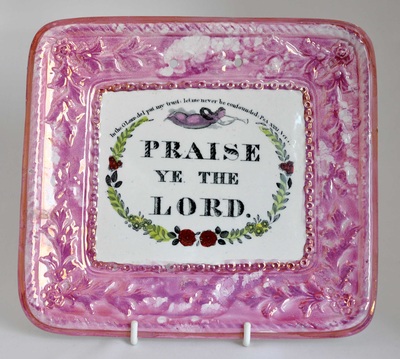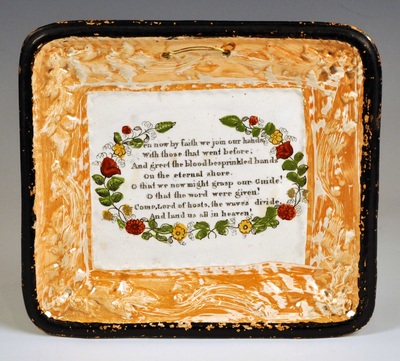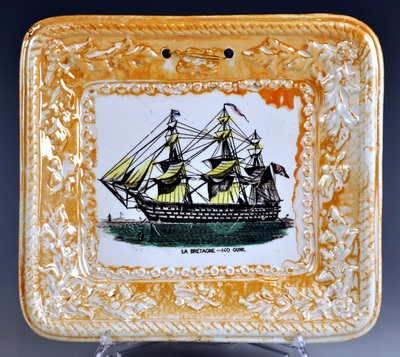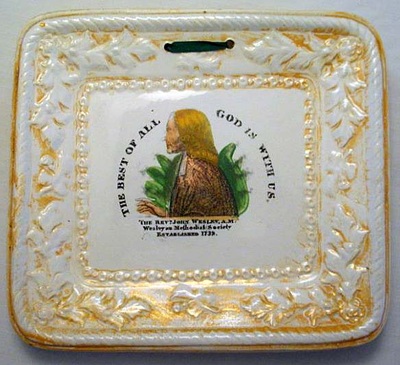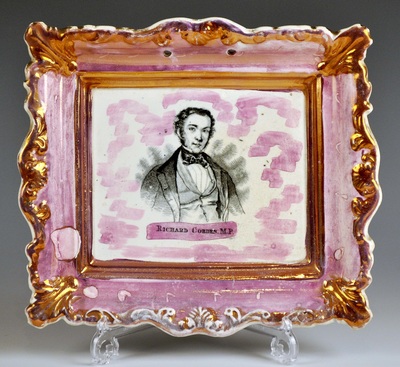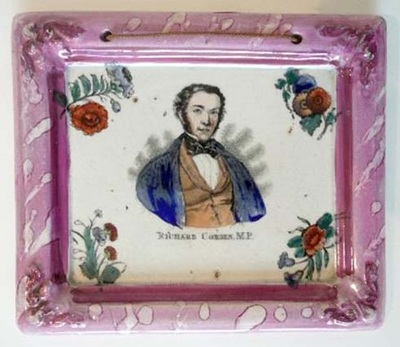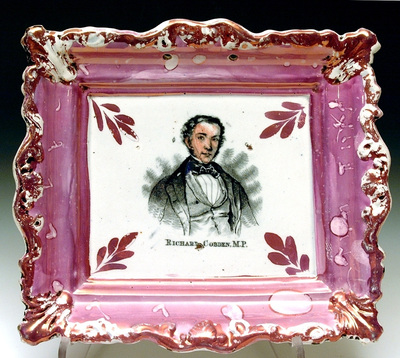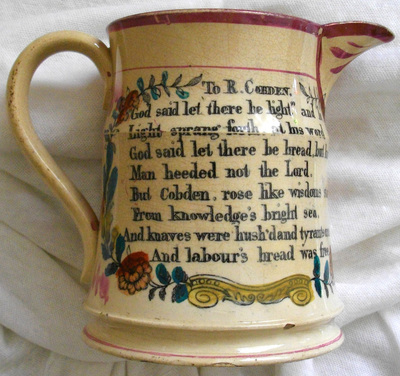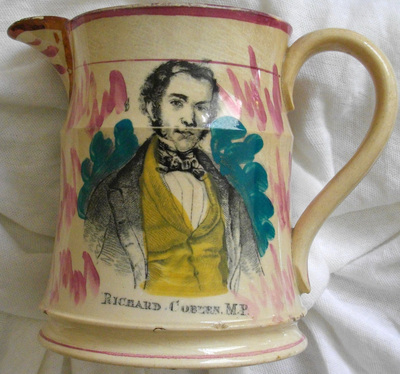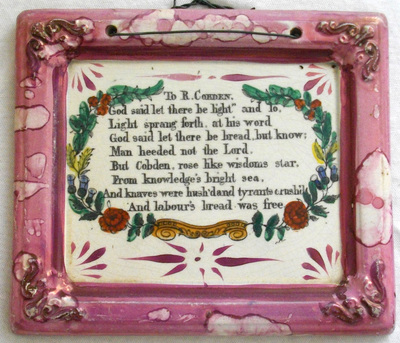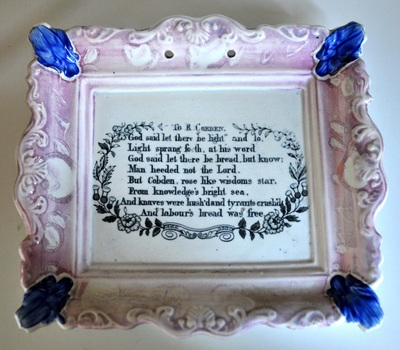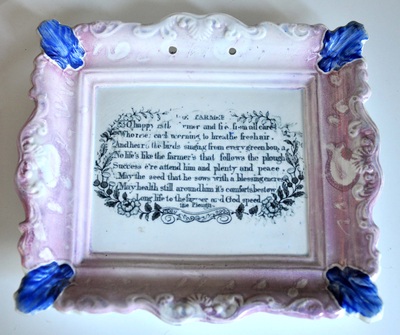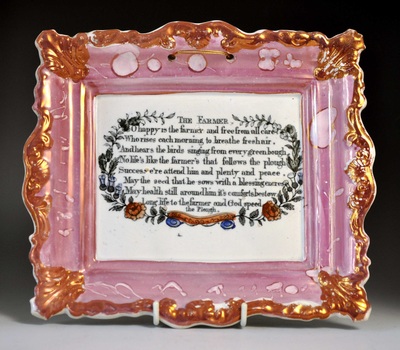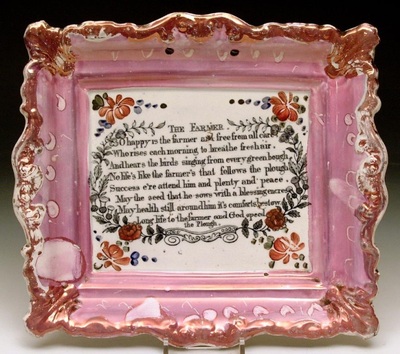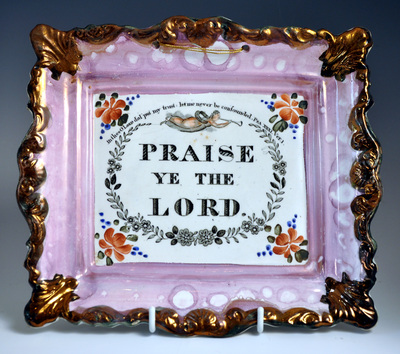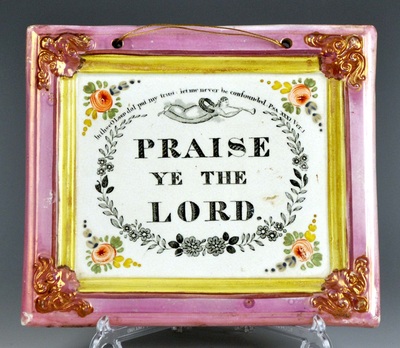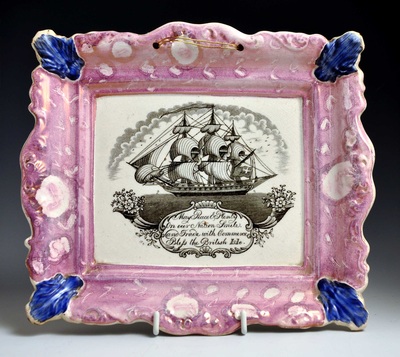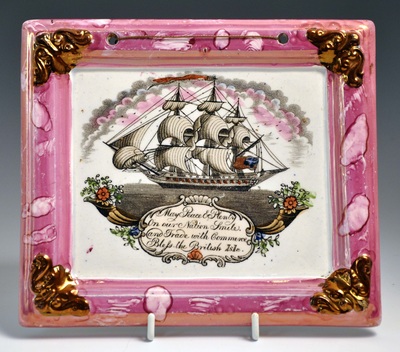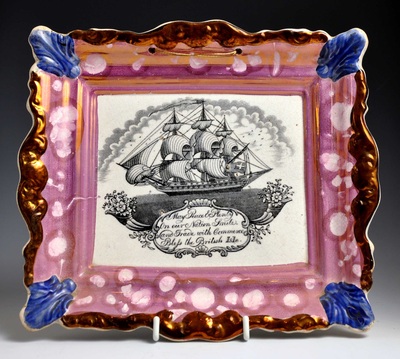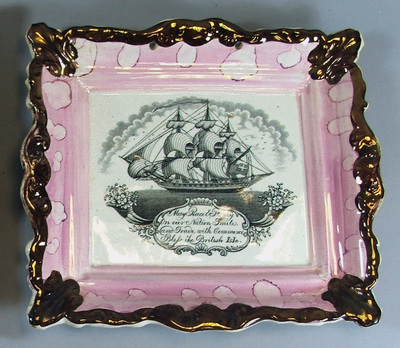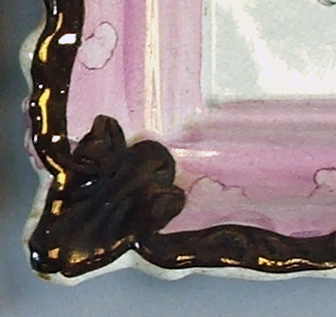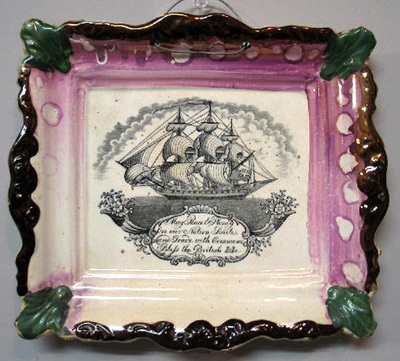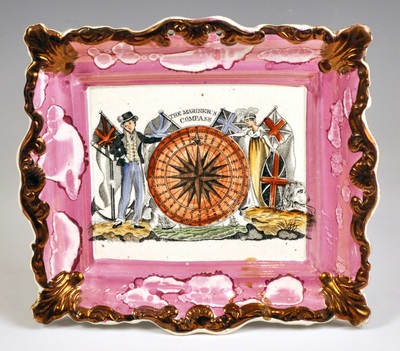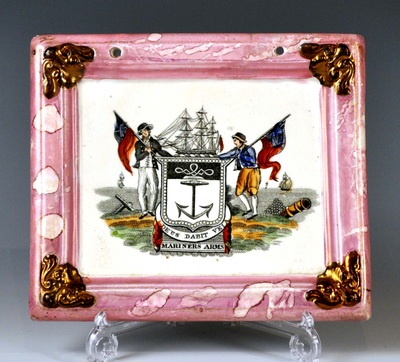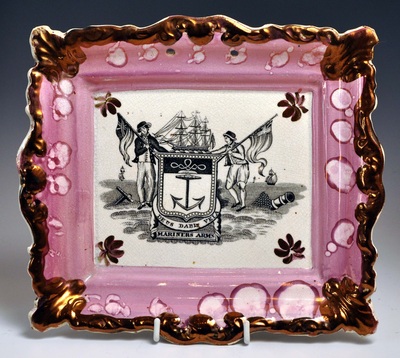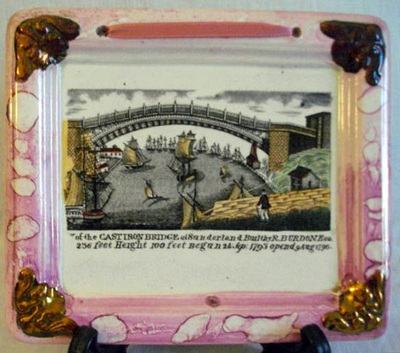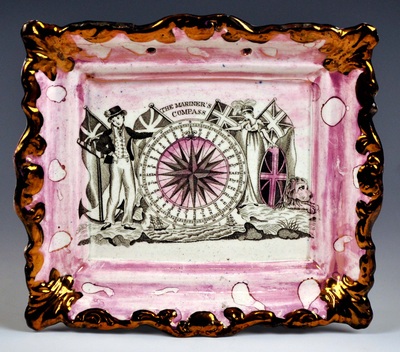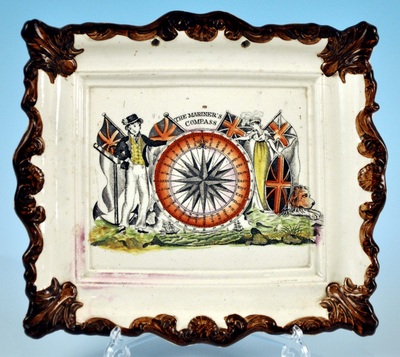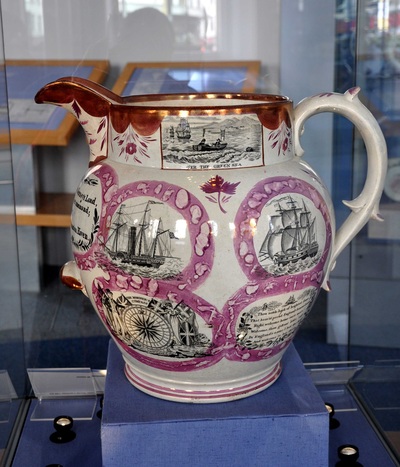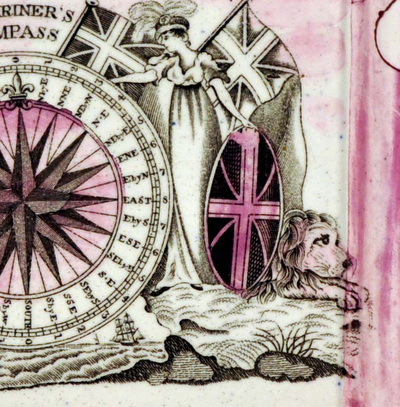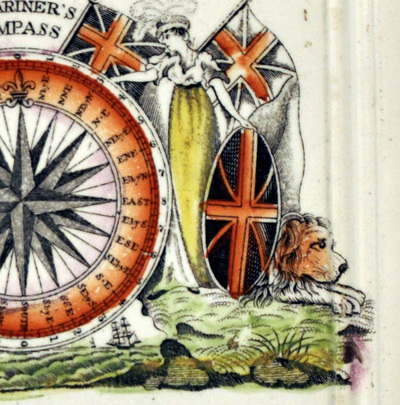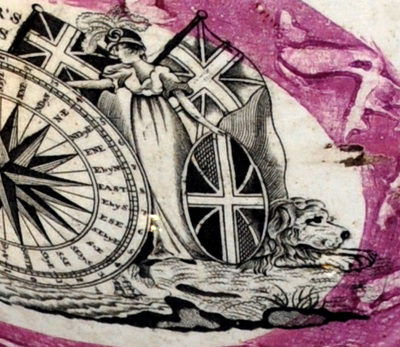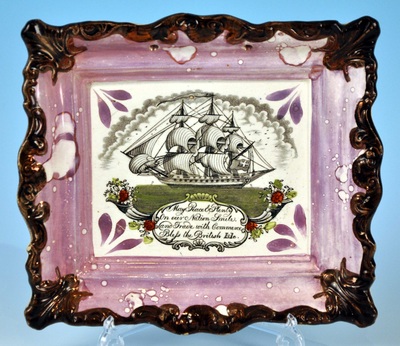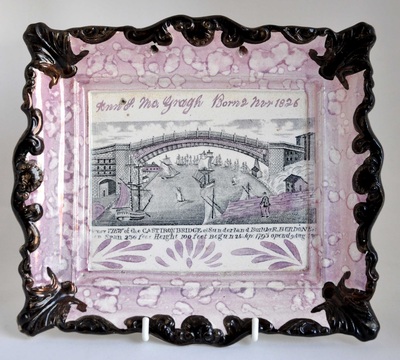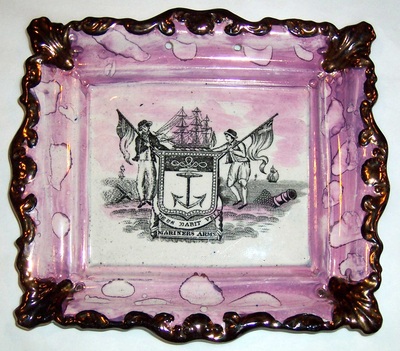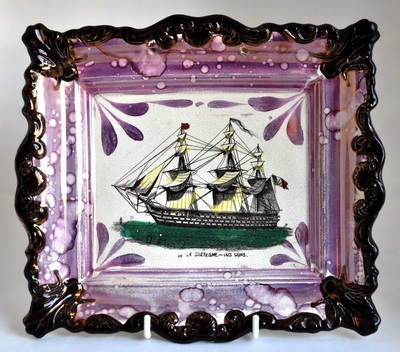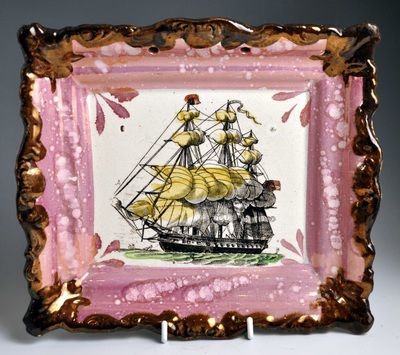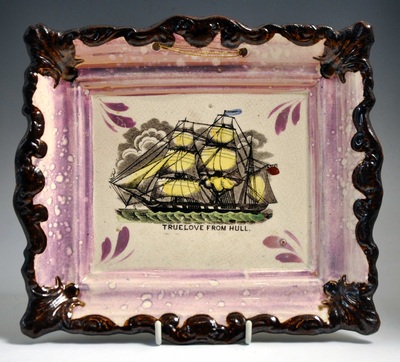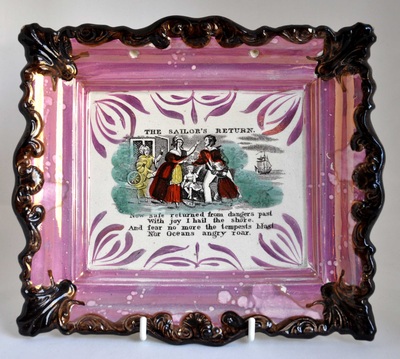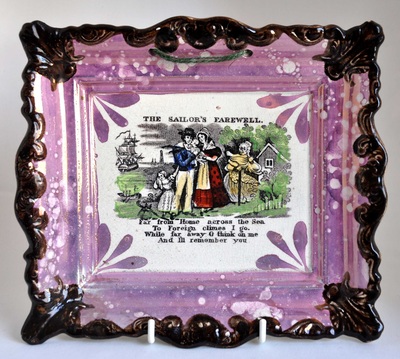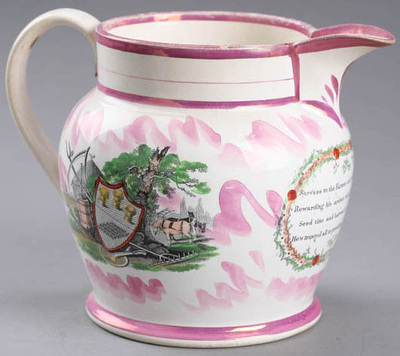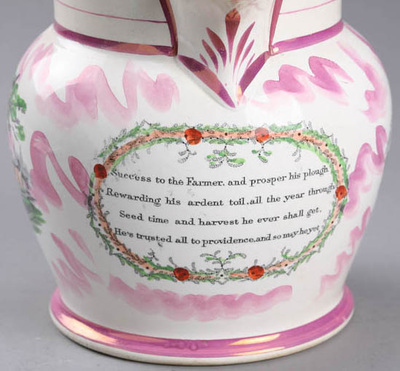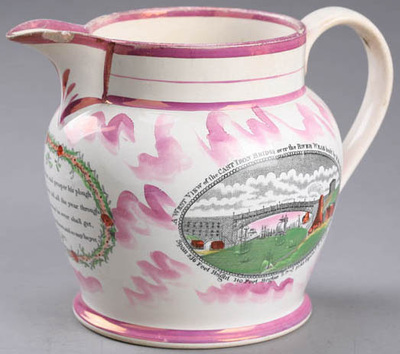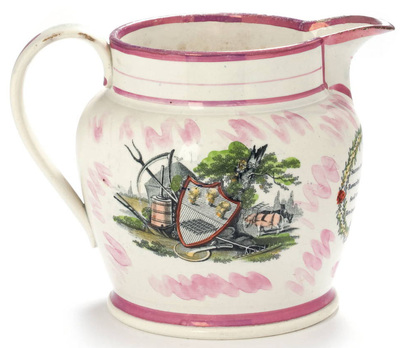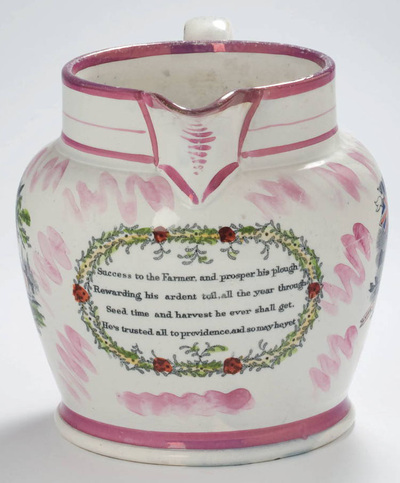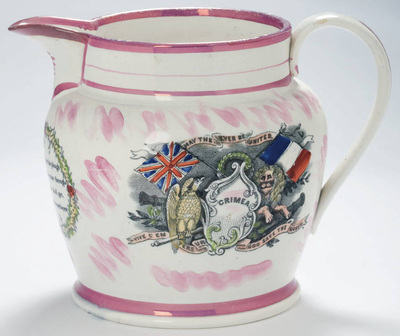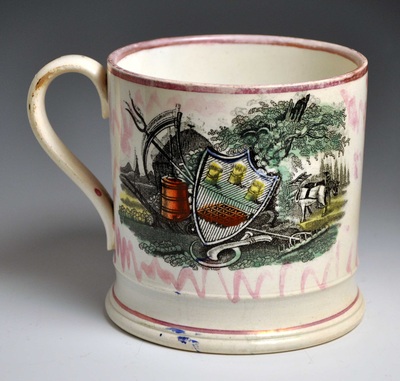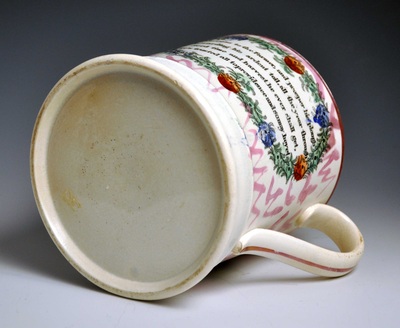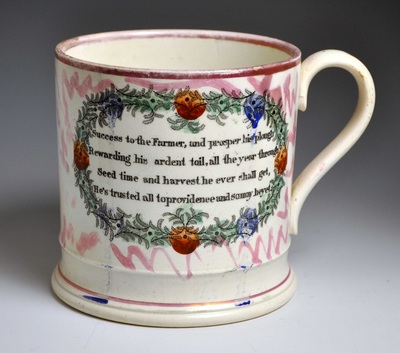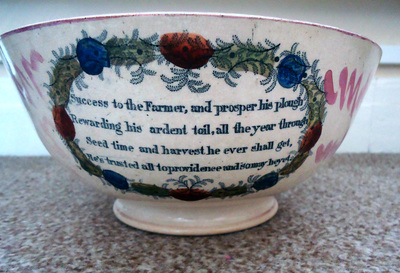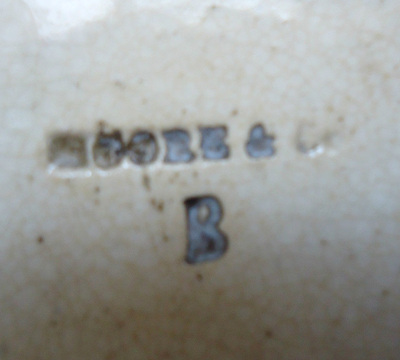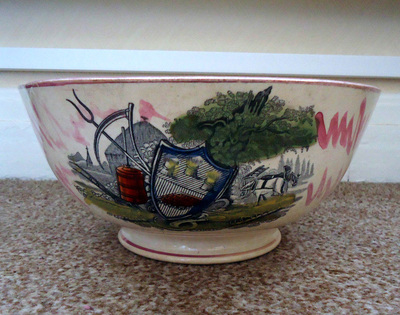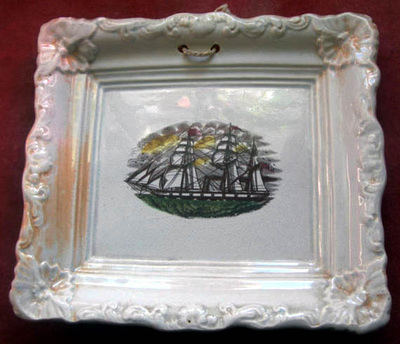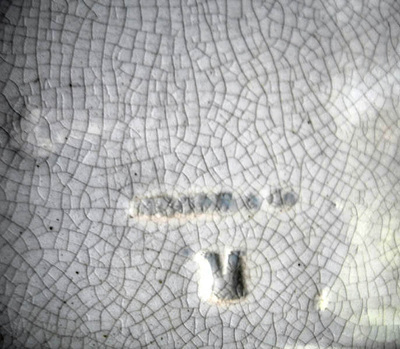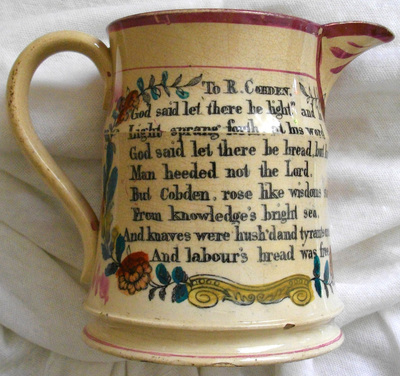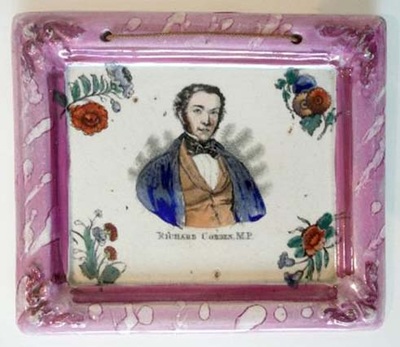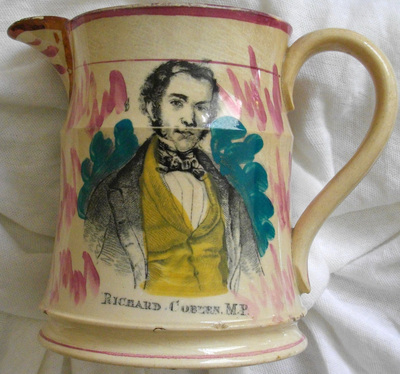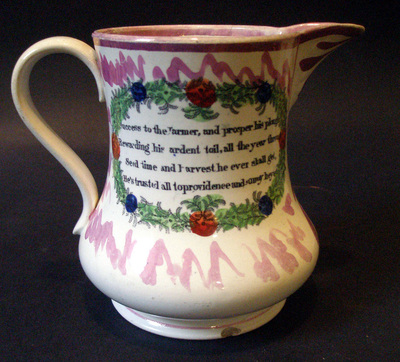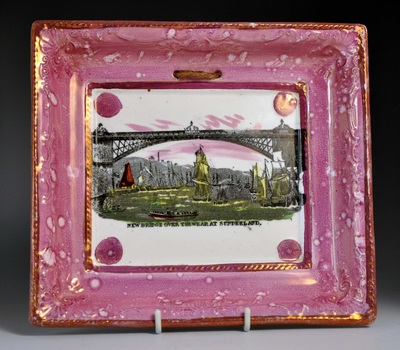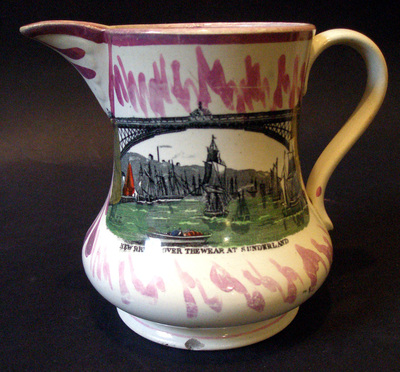|
There are fewer Scott transfers that don't appear on Moore items than I first thought when I started this blog a few years ago. For instance, the two Moore bowls at the end of my last post have transfers like 'A Frigate in Full Sail' and 'The Pensioners Yarn', which I previously thought belonged exclusively to Scott, because they've not yet been recorded on Moore plaques. But if we look back to the pre-1860 period, there are two distinct groups of Scott-attributed transfers, which don't appear on Moore wares (or at least, not until c1865 and the orange lustre period). What's more, each of those 'Scott' groups has its own associated plaque forms and decoration. There is no cross pollination between the two groups. All of this troubled me. How did the plaque moulds and transfer plates of these two Scott groups remain so completely apart? The most obvious answer would be that they were separated geographically, and the two groups come from two different potteries. In which case, would the real Anthony Scott please stand up? Alternatively, they could have been separated temporally, and each belong to a different era of Scott production. In that case, the moulds and transfer plates of one of the groups must have lain dormant in an attic somewhere for a period. What I mean will become clearer if you read on. Scott group 1Some of the transfer plates in this group date from as early as the 1830s. Very unusually, two still exist (now in the New Room, John Wesley's Chapel, Bristol); one of which is shown below. These images of John Wesley, and its pair, Adam Clarke, along with the Charles Wesley verses appear frequently on typical Scott items, like the cup below (click on the images to enlarge). They appear on small round and rectangular plaques from about 1832 onwards (the year of Clark's death). A plaque apparently from the same rectangular mould, and with the date inscription '1838' came up in an auction at Dreweatt Neate a few years ago (see below). But these transfers never appear on the heavy brown-bordered plaques commonly associated with Scott from the 1860s. And they never appear on pink-lustre Moore plaques. But interestingly, the Wesley transfer and the common religious verses (Sunderland plate 1) appear on the finely moulded plaques below. Verses on these plaques have been recorded with hand-painted inscriptions and the dates 1858, and 1860. So there is a 20-year gap between the plaque forms above and below, during which the transfer plates appear to have been out of service. Other transfers that appear on these plaques are the Farmers' Arms, the Sailor's Return, maritime and farming verses (see Dick Henrywood, Poor Man's Pictures, Part II, for a 'Success to the Farmer' verse), West View of the Cast Iron Bridge over the Wear, and New Bridge over the River Wear. The New Bridge opened in 1859, but this bridge transfer originated in the Garrison Pottery and first appeared on Dixon items. The transfer plate was likely bought by Scott when the Garrison Pottery closed in 1865, which helps us date the last two plaques below. So, at the same time Scott is said to have mass-produced the brown-bordered plaques, they were also, apparently, making the finely potted and high-quality items below. Religious verses (Prepare to Meet Thy God, etc) on these plaques are common. John Wesley, the Farmers' Arms and New Bridge plaques are rarer (I've seen a handful in the last 15 years). But the others are so rare I've only ever seen one of each. The fine potting and decoration of plaques from this mould didn't last. By the 1870s the potting had become clunky, and the transfers less carefully applied (see left below). In this later period, transfers from the brown-bordered plaques begin to make it onto this plaque form. The square plaque form below, in the pink-lustre period (c1860s), appears to have been used only with the common verse transfers in this group (Sunderland plate 1), although there may be a John Wesley or an Adam Clark out there somewhere. By the orange lustre period (c1870s), transfers that appear on brown-bordered plaques make it onto this form (see top centre). The orange lustre is often degraded, with deterioration of the detail of the moulding, and the plaques are more heavily potted. The similarly moulded rectangular form with rounded corners is always heavily potted (even the pink-lustre versions). It is found with the Scott group 1 transfers, and with the ship transfers that originated at Moore's. The quality of the Wesley plaque below is so poor that it likely post-dates the Scott period (ie post 1897), and was made when the moulds and transfer plates moved to Ball's Deptford Pottery. Scott group 2The Scott group 2 transfers appear to originate in the 1840s. Richard Cobden and verses relating to him and farming appear on the two plaque forms below. Cobden was a hugely popular figure in 1846 because he'd been instrumental in repealing the corn laws, and lowering the price of bread. But Cobden was a pacifist and opposed action in the Crimea (a popular war) so by the mid 1850s he'd fallen from public favour. This allows us to fairly accurately date these plaque forms. They are more heavily potted than the plaques with the Moore impress from this period. Although the transfer never appears on plaques with Moore marks or with typical Moore decoration, it does appear on other later items. The jug below, for instance, has zig-zag lustre decoration (like the letter 'M') often associated with Moore. Previously I've mused over the suggestion that this jug was made by Carr. But I now think that unlikely. The decoration of the Cobden verse on the jug is very similar to that on the 'Scott' plaques. The Cobden verse also appears on plaques with blue corners, as does a verse titled 'The Farmer'. The flower decoration on the bottom left plaque is the same as that found on verse plaques attributed to Scott (Sunderland plate 3). If the blue corners look familiar, hold that thought. They also appear on Scott-attributed 'May Peace and Plenty' plaques. A feature of some of the plaques in this group is a copper-lustre border, carefully painted to the outside edge (see below centre). These plaques are more finely potted than the later Scott-attributed plaques with brown borders, on which this transfer also commonly appears. (Cobden and his related verses never make it onto the brown-bordered plaques, probably because of his wain in popularity as discussed above.) Other transfers found on these 'group 2' plaque forms are the Mariner's Compass, Mariners' Arms, and the 'Cast Iron Bridge' over the River Wear. Now here's what troubled me. The reason these plaques are attributed to Scott is solely that the transfers also appear on the typical 'Scott' brown-bordered plaques (like the one centre below). Unlike the 'group 1' transfers, I'm not yet aware of them appearing on early Scott items. So could this limited group of transfer plates have been acquired from another pottery, and the plaques above been made somewhere else? There are many variations of the Mariners' Arms transfer, used by several potteries, so that's not much help. The Mariner's Compass, on the other hand, appears less frequently. I remembered it on a Seaham jug in the Sunderland Museum, but looking at the details below, the third (from the jug) is clearly from a different transfer plate. Click on the images to enlarge. Could all of these group 2 items have been made by Moore, as the Cobden jug might suggest? Potentially they could, but the same issues would still need to be addressed. Why was this group of transfers and plaque moulds kept so completely distinct from Moore's other items? Why do they never appear with Moore impressed marks, during a period when Moore put their mark on everything else? And why is the decoration so different from Moore's other items of the period? All things considered, they do still seem more likely to be Scott, made during the 20-year period between the early group 1 plaques, and the later group 1 plaques. What else was Scott doing during that time? Now here's one more puzzle. The ships that appear on brown-bordered plaques (bottom row below) frequently appear on orange-lustre plaques, along with transfers from 'group 1' above. And yet the transfers of 'group 2' (top row below), which also appear on brown-bordered plaques, have never been recorded with orange lustre. So even amongst the brown-bordered plaques, there appears to be a division of two groups. Could the brown bordered plaques have been made by two different potteries (Scott and Moore)? The main argument against this is the homogeneity of decoration and quality of lustre of the plaques below. Finally, here's another category of brown-bordered plaques, with transfers that neither appear on early Moore plaques, nor late orange-lustre 'Scott' plaques. I'm sure there are more! P.S.Below are two jugs, which further tie the 'group 1' transfers to Scott. The decoration is typical of that pottery, with soft curvy squiggles, and like the plaques, the jugs are of a high quality. On the first jug, the third transfer is of the old bridge, so it could pre-date 1859. The Crimean transfer on the second jug might also suggest an 1850s' date, although I suspect this transfer was used into the 1860s and perhaps beyond. Now compare the quality with the Moore items below, which have the same transfers (the mug is unmarked and attributed to Moore on the basis of the zig-zag decoration). It seems possible that the transfer plates started off at Scott, and moved to Moore at a later date. This might be borne out by letter 'B' under the impress on the bowl. A similar lettered impress appears on an orange ship plaque from post 1870. However, as Norman Lowe has suggested, it is also possible that by this period both potteries were sending wares to Sheepfolds Warehouse to be decorated. I think something similar can be said of the Cobden jug, with its clumsy decoration. Ian Holmes has suggested that the Cobden transfer might have been revived in 1865, to commemorate his death. Ian Sharp has a similar jug for sale on his website, which he also attributes to Moore. It has the New Bridge transfer, acquired from the Garrison Pottery in 1865. So the transfers from group 1 (bottom row) finally come together with those from group 2 (top row) on Moore-attributed items. Although the relationship between the two potteries is complex, I do believe that one day somebody will be able to unpick it. As always, if you have items or information that might help, please get in touch.
1 Comment
|
AuthorStephen Smith lives in London, and is always happy to hear from other collectors. If you have an interesting collection of plaques, and are based in the UK, he will photograph them for you. Free advice given regarding selling and dispersal of a collection, or to those wishing to start one. Just get in touch... Archives
February 2022
AcknowledgementsThis website is indebted to collectors, dealers and enthusiasts who have shared their knowledge or photos. In particular: Ian Holmes, Stephen Duckworth, Dick Henrywood, Norman Lowe, Keith Lovell, Donald H Ryan, Harold Crowder, Jack and Joyce Cockerill, Myrna Schkolne, Elinor Penna, Ian Sharp, Shauna Gregg at the Sunderland Museum, Keith Bell, Martyn Edgell, and Liz Denton.
|
